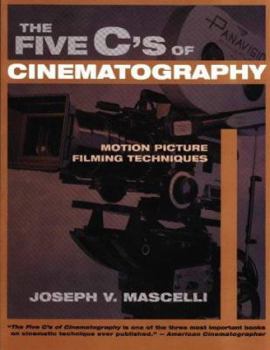Five C's of Cinematography: Motion Picture Filming Techniques
Select Format
Select Condition 
Book Overview
The Five C's of Cinematography is one of the three most important books on cinematic technique ever published -- American Cinematographer This description may be from another edition of this product.
Format:Paperback
Language:English
ISBN:187950541X
ISBN13:9781879505414
Release Date:August 2005
Publisher:Silman-James Press
Length:251 Pages
Weight:1.50 lbs.
Dimensions:0.6" x 8.6" x 11.1"
Customer Reviews
5 ratings
A stilll relivant clasic
Published by Thriftbooks.com User , 18 years ago
While some of the references are somewhat dated the techniques this book promotes are still valid and useful. Some are now fashionable to flaunt like crossing views, but this makes some TV unwatchable because its jolting. The concept to protecting shots seems to have been lost in the video world as an editor I find this much more useful that the so-called coverage junk that I often have to deal with. Reshooting exactly the same scene from the same POV 13 times is NOT useful coverage! The editor needs ways to cut around mistakes and build up scenes by mix and match to do this he needs well thought out shooting not endless repetitions. If everyone who wants to be a director would read and pay attention to this book film and video quality would improve immensely! While this book is an essential read for directors, DPs and cameramen; I would highly recommend it to gaffers, grip and sound guys.
A timeless must-read for filmmakers and videographers
Published by Thriftbooks.com User , 20 years ago
This book was written in 1965, yet none of it's information is out-of-date. This book covers the basics of cinematography which is the art of motion picture filming. It's very easy to read and all terms are defined and explained by the author before being used so it's easy to understand. The author organizes everything you need to know about shooting films into five categories that start with "C", so it's simplified and easy to remember. It doesn't matter if you're a filmmaker, a cameraman, or even a still photographer this book is worth the read. Also, if you edit video in Adobe Premiere or Final Cut Pro and are pretty much clueless, the chapter on cutting will be of great value to you. This book is more about philosophy than any technical information about cameras or types of film. After reading this book you'll have a better understanding of how to communicate a story to people with the moving picture.
Finally, a Filmmaking Book About Filmmaking
Published by Thriftbooks.com User , 21 years ago
If you're like me and you've sifted through dozens of books on film technique that were about anything but, you can stop searching. "The Five C's of Cinematography" is not only well-written but virtually everything in it is essential to learning good film technique. Most authors of these types of books either don't completely understand the medium, aren't interested in sharing their wisdom or are just looking to make a quick buck. Mascelli delivers all the goods. He provides the best explanation of the axis line I've ever read and his diagrams are simple, yet very helpful. This is a guy who clearly wanted to share his knowledge. You can throw out all your other filmmaking books.
The Bible of Cinematography
Published by Thriftbooks.com User , 22 years ago
The five C's: camera angles, continuity, cutting, close-ups, and composition. This book takes the filmmaker through understanding exactly what goes into getting the best image imaginable onto film. The true treasure of this book is that is was written long ago enough that the author does not feel bound to polical writing: in this authors world there are black and white rules of what is acceptable and unacceptable. While "creative-types" may find his insistance on what can be done insulting to their vision, I think we can all agree that if you are going to break the rules, it is important to know them. If you read this book and study it, then you will KNOW the rules and UNDERSTAND when, why, and where you need to break them. It is a delightful read, filled with information, and though written in the 1960's... the concepts are timeless and very applicable to filmmakers in the 2000's. Buy it and enjoy it! Best Wishes....Jason
Great Introduction to Film Making
Published by Thriftbooks.com User , 24 years ago
As an amateur just starting to get serious about turning my "home movies" into something people actually WANT to watch, I searched for a long time to find an introductory book that not only told you HOW to do things, but WHY you should do them.After many disappointments, I found this book. While some of the references (script girl is particularly amusing) are very dated, the text mainly covers technique and avoids technology. The illustrations and printing style point quite obviously to the book's mid-60s origin. An introduction by someone who remembers what it was like to shoot film in 1908 and knew D.W. Griffith personally should tip you off immediately that this book is something special. Still, the illustrations are clear and help illustrate the text's points very well.In spite of what many recent amateur (and professional) film makers think, technology does not make your film good, it just makes it easy. TECHNIQUE makes it good. And that's what this book teaches in a very clear, readable, and understandable way.Very highly recommended if you've had your fill of general introductory texts and are looking for real instruction and explanation for how to actually MAKE a film.





